-
SCAM WARNING! See how this scam works in Classifieds.
You are using an out of date browser. It may not display this or other websites correctly.
You should upgrade or use an alternative browser.
You should upgrade or use an alternative browser.
I just saw the moon
- Thread starter TheMadDabber
- Start date

Where no ice was seen before: Team designs lunar satellite tools to hunt for water | Orlando Sentinel
ORLANDO, Fla. -- When Kerri Donaldson Hanna looks at the full moon she sees a future full of opportunity. “I see so much possibility. Humans have put their feet there, looked back at Earth, and saw it as that object in the sky,” said Hanna, a planetary geologist at the University of Central...
No Longer Available
cybrguy
Putin is a War Criminal
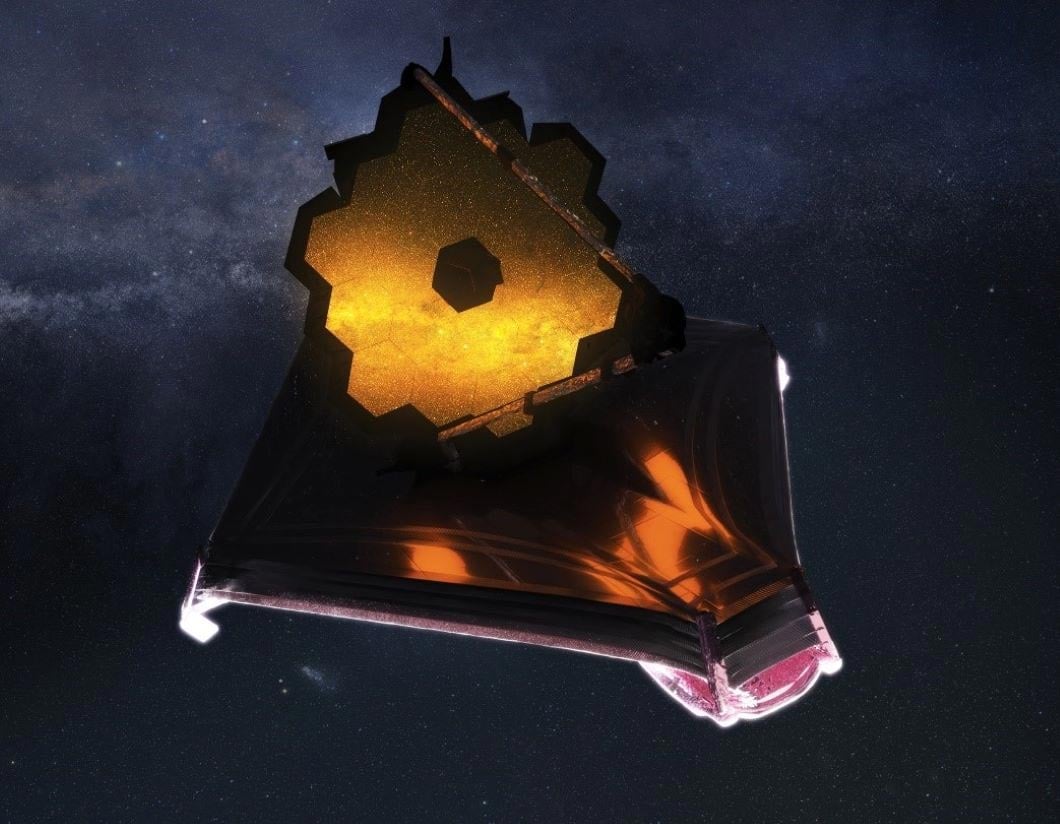
NASA’s $10 Billion Webb Space Telescope Struck by Micrometeoroid
NASA’s James Webb Space Telescope sustained an impact to one of its primary mirror segments between May 23 and 25. Our solar system is filled with small particles of rock or metal called micrometeoroids. These tiny meteoroids typically weigh less than a gram, yet they still pose a significant thr
scitechdaily.com
stark1
Lonesome Planet
This reported version overinflated “micrometeroid”, a tiny speck
Of dust (traveling at high velocity), into an “Asteroid!” which impacted
Into the C3 segment of the $10 billion WST— the 5th such impact on
The open platform telescope. Almost six months out in its Lagrange position.
Almost minimal damage.


Meanwhile, images are forthcoming from NASA on July 12.
Of dust (traveling at high velocity), into an “Asteroid!” which impacted
Into the C3 segment of the $10 billion WST— the 5th such impact on
The open platform telescope. Almost six months out in its Lagrange position.
Almost minimal damage.


Meanwhile, images are forthcoming from NASA on July 12.
CrazyDiamond
HAL is a StarChild
These cosmic clouds of gas and dust drift through rich star fields along the plane of our Milky Way Galaxy toward the high flying constellation Cygnus. They're too faint to be seen with the unaided eye though, even on a clear, dark night. Image data from a camera and telephoto lens using narrowband filters was used to construct this 10 degree wide field of view. The deep mosaic reveals a region that includes star forming dust clouds seen in silhouette against the characteristic glow of atomic hydrogen and oxygen gas. NGC 6888 is the standout emission nebula near the top. Blown by winds from a massive Wolf-Rayet star it's about 25 light-years across and known as the Crescent Nebula. A faint bluish curl just below center in the frame is also the signature of a Wolf-Rayet star. Burning fuel at a prodigious rate and near the end of their stellar lives, both stars will ultimately go out with a bang in a spectacular supernova explosion. Toward the right, a massive, young O type star powers the glow of Sh2-101, the Tulip Nebula.
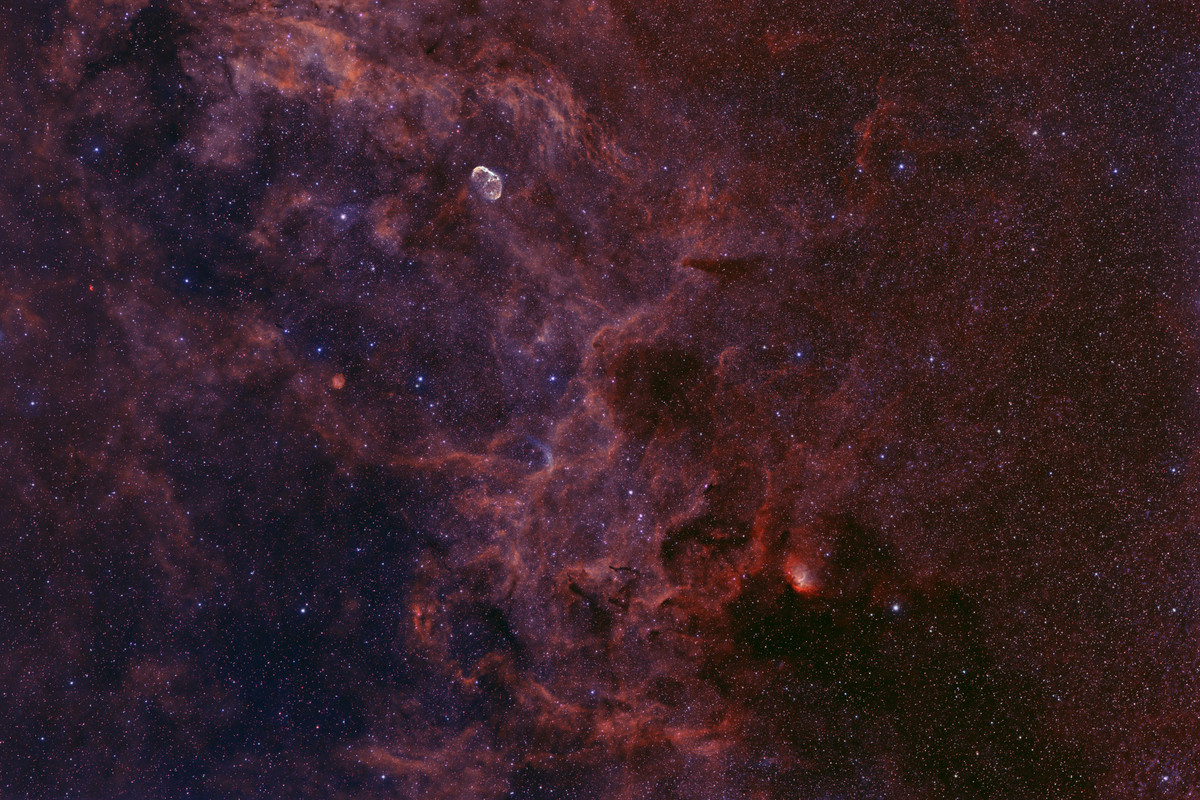
Do dragons fight on the altar of the sky? Although it might appear that way, these dragons are illusions made of thin gas and dust. The emission nebula NGC 6188, home to the glowing clouds, is found about 4,000 light years away near the edge of a large molecular cloud unseen at visible wavelengths, in the southern constellation Ara (the Altar). Massive, young stars of the embedded Ara OB1 association were formed in that region only a few million years ago, sculpting the dark shapes and powering the nebular glow with stellar winds and intense ultraviolet radiation. The recent star formation itself was likely triggered by winds and supernova explosions, from previous generations of massive stars, that swept up and compressed the molecular gas. Joining NGC 6188 on this cosmic canvas, visible toward the lower right, is rare emission nebula NGC 6164, also created by one of the region's massive O-type stars. Similar in appearance to many planetary nebulae, NGC 6164's striking, symmetric gaseous shroud and faint halo surround its bright central star near the bottom edge. This impressively wide field of view spans over 2 degrees (four full Moons), corresponding to over 150 light years at the estimated distance of NGC 6188.

This infrared view of the star formation region Messier 8, often called the Lagoon Nebula, was captured by the VISTA telescope at ESO’s Paranal Observatory in Chile. This image is a wider version of eso1001a and was created from images taken through J, H and Ks near-infrared filters, It was acquired as part of a huge survey of the central parts of the Milky Way. The field of view is about 72 by 39 arcminutes.
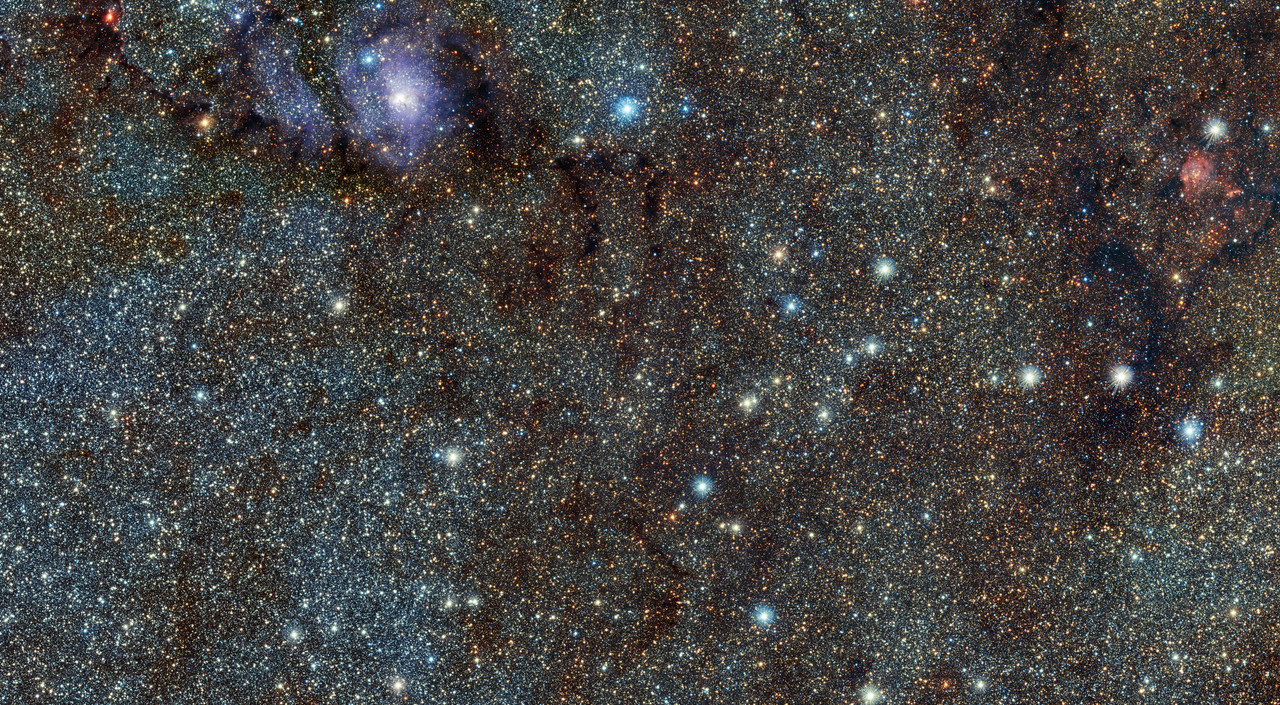
This image compares infrared and visible views of the Lagoon Nebula (Messier 8). The visible light image (lower) was taken with the Wide Field Imager on the MPG/ESO 2.2-metre telescope at La Silla in Chile. The new infrared image (upper) was taken with the VISTA telescope at ESO’s Paranal Observatory. In the infrared, the rich dust clouds become more transparent and the gas clouds less conspicuous. A whole host of cool red stars that are otherwise invisible can be seen.
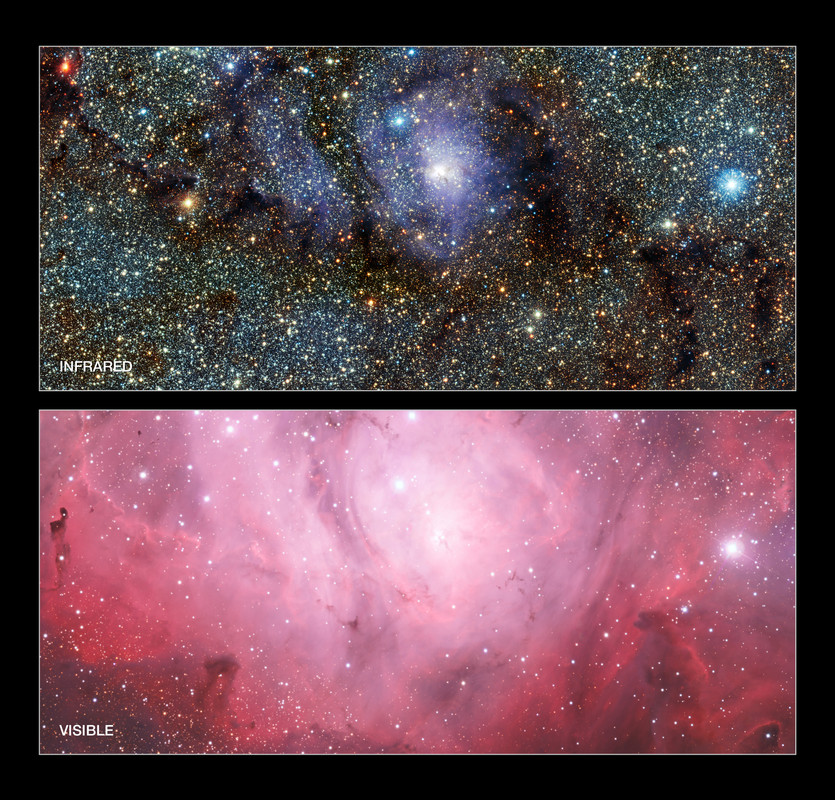
This dramatic infrared image shows the nearby star formation region Monoceros R2, located some 2700 light-years away in the constellation of Monoceros (the Unicorn). The picture was created from exposures in the near infrared bands Y, J and Ks taken by the VISTA survey telescope at ESO’s Paranal Observatory. Monoceros R2 is an association of massive hot young stars illuminating a beautiful collection of reflection nebulae, embedded in a large molecular cloud.
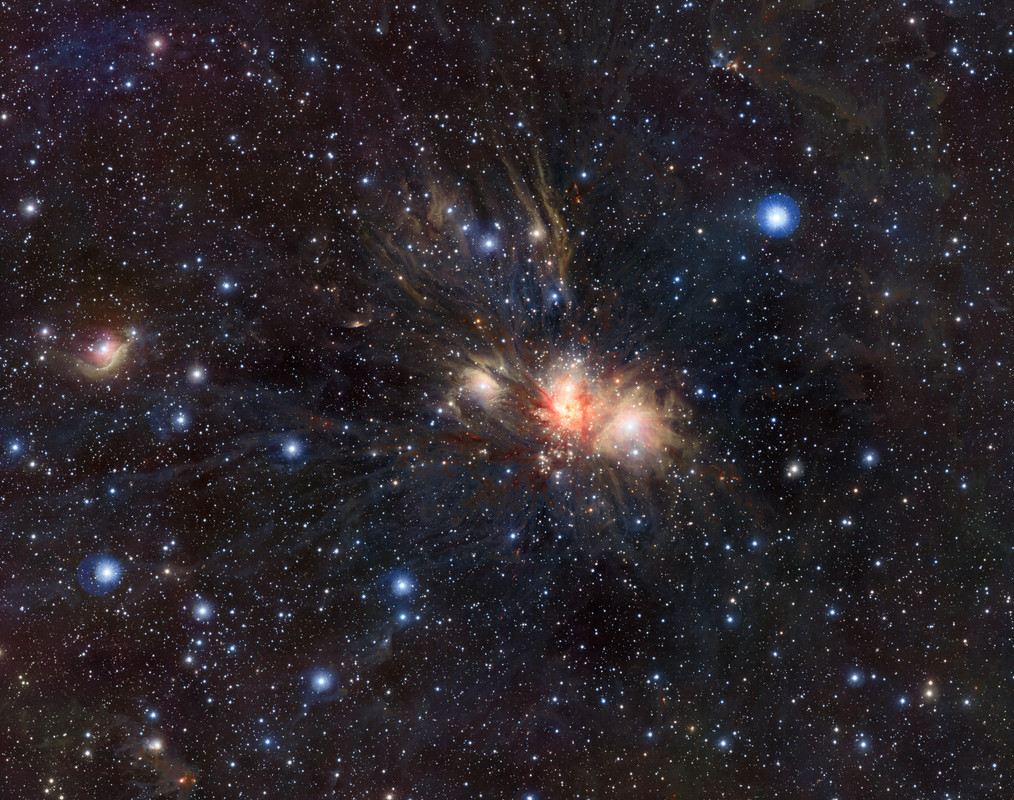
This image compares infrared and visible views of the Monoceros R2 star-forming region. The visible light image (left) was created from digitized photographs through red and blue filters forming part of the Digitized Sky Survey 2. The new infrared image (right) was taken with the VISTA telescope at ESO’s Paranal Observatory. In the infrared, the thick rich dust clouds that cover much of the image become nearly transparent and a whole host of young stars and associated outflows become apparent.
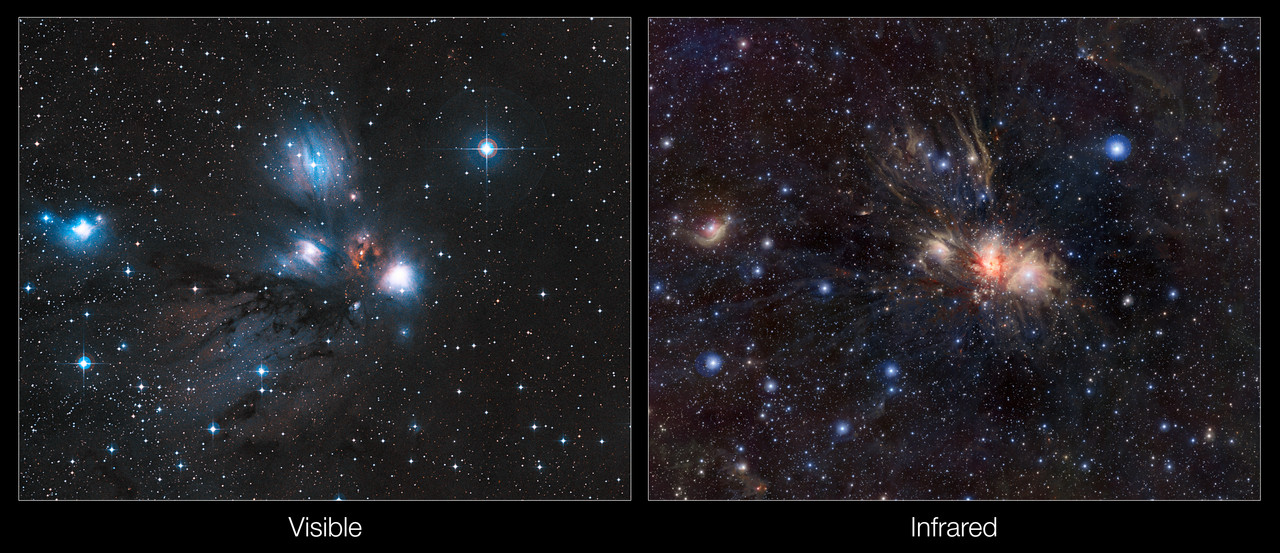
This image of part of the Carina Nebula was created from images taken through red, green and blue filters with the Wide Field Imager on the MPG/ESO 2.2-metre telescope at ESO’s La Silla Observatory in Chile. It is centered on the unusual hot massive young star WR 22, a member of the rare class of Wolf–Rayet stars. The field of view is 0.55 x 0.55 degrees, covering a 72 x 72 light-year region at the distance of the nebula.


Do dragons fight on the altar of the sky? Although it might appear that way, these dragons are illusions made of thin gas and dust. The emission nebula NGC 6188, home to the glowing clouds, is found about 4,000 light years away near the edge of a large molecular cloud unseen at visible wavelengths, in the southern constellation Ara (the Altar). Massive, young stars of the embedded Ara OB1 association were formed in that region only a few million years ago, sculpting the dark shapes and powering the nebular glow with stellar winds and intense ultraviolet radiation. The recent star formation itself was likely triggered by winds and supernova explosions, from previous generations of massive stars, that swept up and compressed the molecular gas. Joining NGC 6188 on this cosmic canvas, visible toward the lower right, is rare emission nebula NGC 6164, also created by one of the region's massive O-type stars. Similar in appearance to many planetary nebulae, NGC 6164's striking, symmetric gaseous shroud and faint halo surround its bright central star near the bottom edge. This impressively wide field of view spans over 2 degrees (four full Moons), corresponding to over 150 light years at the estimated distance of NGC 6188.

This infrared view of the star formation region Messier 8, often called the Lagoon Nebula, was captured by the VISTA telescope at ESO’s Paranal Observatory in Chile. This image is a wider version of eso1001a and was created from images taken through J, H and Ks near-infrared filters, It was acquired as part of a huge survey of the central parts of the Milky Way. The field of view is about 72 by 39 arcminutes.

This image compares infrared and visible views of the Lagoon Nebula (Messier 8). The visible light image (lower) was taken with the Wide Field Imager on the MPG/ESO 2.2-metre telescope at La Silla in Chile. The new infrared image (upper) was taken with the VISTA telescope at ESO’s Paranal Observatory. In the infrared, the rich dust clouds become more transparent and the gas clouds less conspicuous. A whole host of cool red stars that are otherwise invisible can be seen.

This dramatic infrared image shows the nearby star formation region Monoceros R2, located some 2700 light-years away in the constellation of Monoceros (the Unicorn). The picture was created from exposures in the near infrared bands Y, J and Ks taken by the VISTA survey telescope at ESO’s Paranal Observatory. Monoceros R2 is an association of massive hot young stars illuminating a beautiful collection of reflection nebulae, embedded in a large molecular cloud.

This image compares infrared and visible views of the Monoceros R2 star-forming region. The visible light image (left) was created from digitized photographs through red and blue filters forming part of the Digitized Sky Survey 2. The new infrared image (right) was taken with the VISTA telescope at ESO’s Paranal Observatory. In the infrared, the thick rich dust clouds that cover much of the image become nearly transparent and a whole host of young stars and associated outflows become apparent.

This image of part of the Carina Nebula was created from images taken through red, green and blue filters with the Wide Field Imager on the MPG/ESO 2.2-metre telescope at ESO’s La Silla Observatory in Chile. It is centered on the unusual hot massive young star WR 22, a member of the rare class of Wolf–Rayet stars. The field of view is 0.55 x 0.55 degrees, covering a 72 x 72 light-year region at the distance of the nebula.

stark1
Lonesome Planet
Are comets
 thought to predict forbodiing disasters?
thought to predict forbodiing disasters?
If so, watch
out. July ~ 14th, a comet with a nucleus twice as large as Mount Everst is tall is sun-bound at its closest
Approach to earth, with it reaching solar perigee in December ~ 19th.
Comets become “active”, develop a coma and a tail, when it is close to the sun, but C/2017 K2 (PanSTARRS) is singular in that it already has a large coma that has sublimated enough to be seen from earth. With a telescope.

At 18 km, about 11 miles, K2 is the second large observed comet ( compared to megaComet C/2014 UN271
(Bernardinelli-Bernstein) which is an astronomical 129 km, or ~ 80 miles, wide ) both inbound towards the sun from the Oort Cloud.

So. If we are still around in 2031, comet Bern-Bern should be making its approach to solar perigee then.
In the meantime, drink lots of Beah, & be Hoppy.
If so, watch
out. July ~ 14th, a comet with a nucleus twice as large as Mount Everst is tall is sun-bound at its closest
Approach to earth, with it reaching solar perigee in December ~ 19th.
Comets become “active”, develop a coma and a tail, when it is close to the sun, but C/2017 K2 (PanSTARRS) is singular in that it already has a large coma that has sublimated enough to be seen from earth. With a telescope.

At 18 km, about 11 miles, K2 is the second large observed comet ( compared to megaComet C/2014 UN271
(Bernardinelli-Bernstein) which is an astronomical 129 km, or ~ 80 miles, wide ) both inbound towards the sun from the Oort Cloud.

So. If we are still around in 2031, comet Bern-Bern should be making its approach to solar perigee then.
In the meantime, drink lots of Beah, & be Hoppy.

Last edited:
Ramahs
Fucking Combustion (mostly) Since February 2017
Are cometsthought to predict forbodiing disasters?
If so, watch
out. July ~ 14th, a comet with a nucleus twice as large as Mount Everst is tall is sun-bound at its closest
Approach to earth, with it reaching solar perigee in December ~ 19th.
Comets become “active”, develop a coma and a tail, when it is close to the sun, but C/2017 K2 (PanSTARRS) is singular in that it already has a large coma that has sublimated enough to be seen from earth. With a telescope.

At 18 km, about 11 miles, K2 is the second large observed comet ( compared to megaComet C/2014 UN271
(Bernardinelli-Bernstein) which is an astronomical 129 km, or ~ 80 miles, wide ) both inbound towards the sun from the Oort Cloud.

So. If we are still around in 2031, comet Bern-Bern should be making its approach to solar perigee then.
In the meantime, drink lots of Beah, & be Hoppy.
Comets are always fun spectacles. I remember Hale-Bopp. I was lucky enough to have a couple friends with large telescopes at the time (you're welcome, Posts Taken out of Context thread), that gave me plenty of access to watch it live

stark1
Lonesome Planet
Comets are always fun spectacles. I remember Hale-Bopp. I was lucky enough to have a couple friends with large telescopes at the time (you're welcome, Posts Taken out of Context thread), that gave me plenty of access to watch it live
We have been blessed with spectacular views of recent comets


A most spectacular sight was Shoemaker-Levy breaking up, and the individual fragments, a”string of pearls” plunging into Jupiter was quite the celestial show

Compared to that, the March, 1986 comet did not make much of an impression on me ( Oh, well, it should be back in
Another 40 years, in 2062,
Halley’s Comet

Ramahs
Fucking Combustion (mostly) Since February 2017
A most spectacular sight was Shoemaker-Levy breaking up, and the individual fragments, a”string of pearls” plunging into Jupiter was quite the celestial show
Yeah. I had access to the same big telescope for that one as well. That was awesome to see

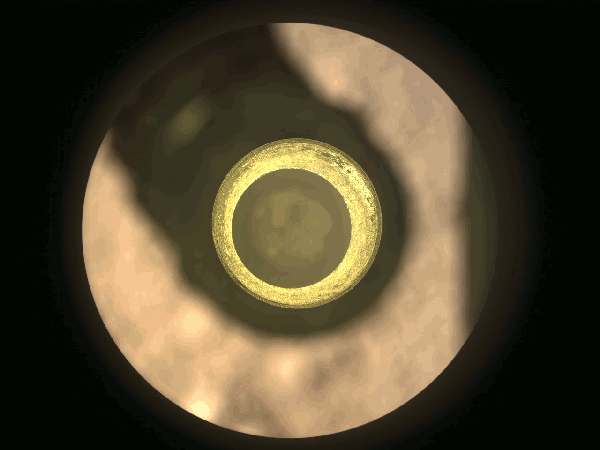
Controversy Grows Over whether Mars Samples Endanger Earth
Planetary scientists are eager to bring Red Planet rocks, soil and even air to Earth, but critics fear the risk of contaminating our world’s biosphere
NYC_Frank
"A man with no vices is a man with no virtues"
Wanted to make sure I shared this with my "i just saw the moon" fc fam just for fun on a Wednesday night 
Post in thread 'The FC GIF Thread!' https://fuckcombustion.com/threads/the-fc-gif-thread.5788/post-1659323
Post in thread 'The FC GIF Thread!' https://fuckcombustion.com/threads/the-fc-gif-thread.5788/post-1659323

Astronauts Suffer Horrific Amount of Bone Loss, Study Finds
In just six months, they experience decades worth of skeletal deterioration.
CrazyDiamond
HAL is a StarChild
Nice video of what Artemis 1 can do.
CrazyDiamond
HAL is a StarChild
Near the horizon the full moon often seems to loom large, swollen in appearance by the famous Moon illusion. But time-lapse image sequences demonstrate that the Moon's angular size doesn't really change as it rises or sets. Its color does, though. Recording a frame about every 60 seconds, this image also shows how red the Sun can look while low on the horizon. The featured montage was taken from Cagliari, Sardinia, Italy, the day after June's Strawberry Moon, a full moon dubbed a supermoon due to its slightly larger-than-usual angular size. This Strawberry Supermoon is seen rising behind the Devil's Saddle, a mountain named for the unusual moon-sized dip seen just to the right of the rising moon. A shrinking line-of-sight through planet Earth's dense and dusty atmosphere shifted the moonlight from strawberry red through honey-colored and paler yellowish hues. That change seems appropriate for a northern June Full Moon also known as the Strawberry or Honey Moon. A Thunder Supermoon -- the third of four supermoons in 2022 -- will occur later this month.


stark1
Lonesome Planet
Last edited:
CrazyDiamond
HAL is a StarChild
Kinda lame stark, but whatever.
Also, haven't heard much about Starship lately....it's because NASA wanted Artemis to launch before Starship got way ahead of them...that's my conspiracy theory and I'm sticking with it.
Ten thousand years ago, before the dawn of recorded human history, a new light would have suddenly have appeared in the night sky and faded after a few weeks. Today we know this light was from a supernova, or exploding star, and record the expanding debris cloud as the Veil Nebula, a supernova remnant. Imaged with color filters featuring light emitted by sulfur (red), hydrogen (green), and oxygen (blue), this deep wide-angle view was processed to remove the stars and so better capture the impressive glowing filaments of the Veil. Also known as the Cygnus Loop, the Veil Nebula is roughly circular in shape and covers nearly 3 degrees on the sky toward the constellation of the Swan (Cygnus). Famous nebular sections include the Bat Nebula, the Witch's Broom Nebula, and Fleming's Triangular Wisp. The complete supernova remnant lies about 1,400 light-years away.
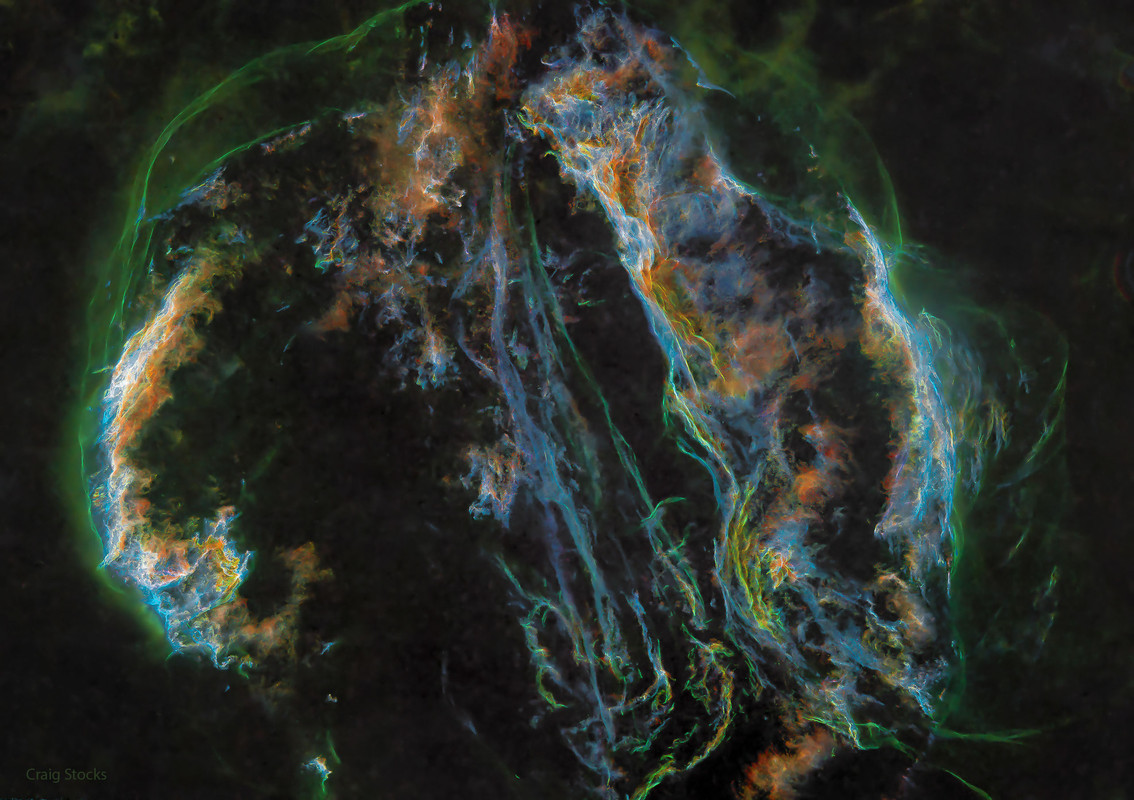
The Virgo Cluster of Galaxies is the closest cluster of galaxies to our Milky Way Galaxy. The Virgo Cluster is so close that it spans more than 5 degrees on the sky - about 10 times the angle made by a full Moon. With its heart lying about 70 million light years distant, the Virgo Cluster is the nearest cluster of galaxies, contains over 2,000 galaxies, and has a noticeable gravitational pull on the galaxies of the Local Group of Galaxies surrounding our Milky Way Galaxy. The cluster contains not only galaxies filled with stars but also gas so hot it glows in X-rays. Motions of galaxies in and around clusters indicate that they contain more dark matter than any visible matter we can see. Pictured here, the heart of the Virgo Cluster includes bright Messier galaxies such as Markarian's Eyes on the upper left, M86 just to the upper right of center, M84 on the far right, as well as spiral galaxy NGC 4388 at the bottom right.

A study in contrasts, this colorful skyscape features stars, dust, and glowing gas in the vicinity of NGC 6914. The interstellar complex of nebulae lies some 6,000 light-years away, toward the high-flying northern constellation Cygnus and the plane of our Milky Way Galaxy. Obscuring interstellar dust clouds appear in silhouette while reddish hydrogen emission nebulae, along with the dusty blue reflection nebulae, fill the cosmic canvas. Ultraviolet radiation from the massive, hot, young stars of the extensive Cygnus OB2 association ionize the region's atomic hydrogen gas, producing the characteristic red glow as protons and electrons recombine. Embedded Cygnus OB2 stars also provide the blue starlight strongly reflected by the dust clouds. The over 1 degree wide telescopic field of view spans about 100 light-years at the estimated distance of NGC 6914.
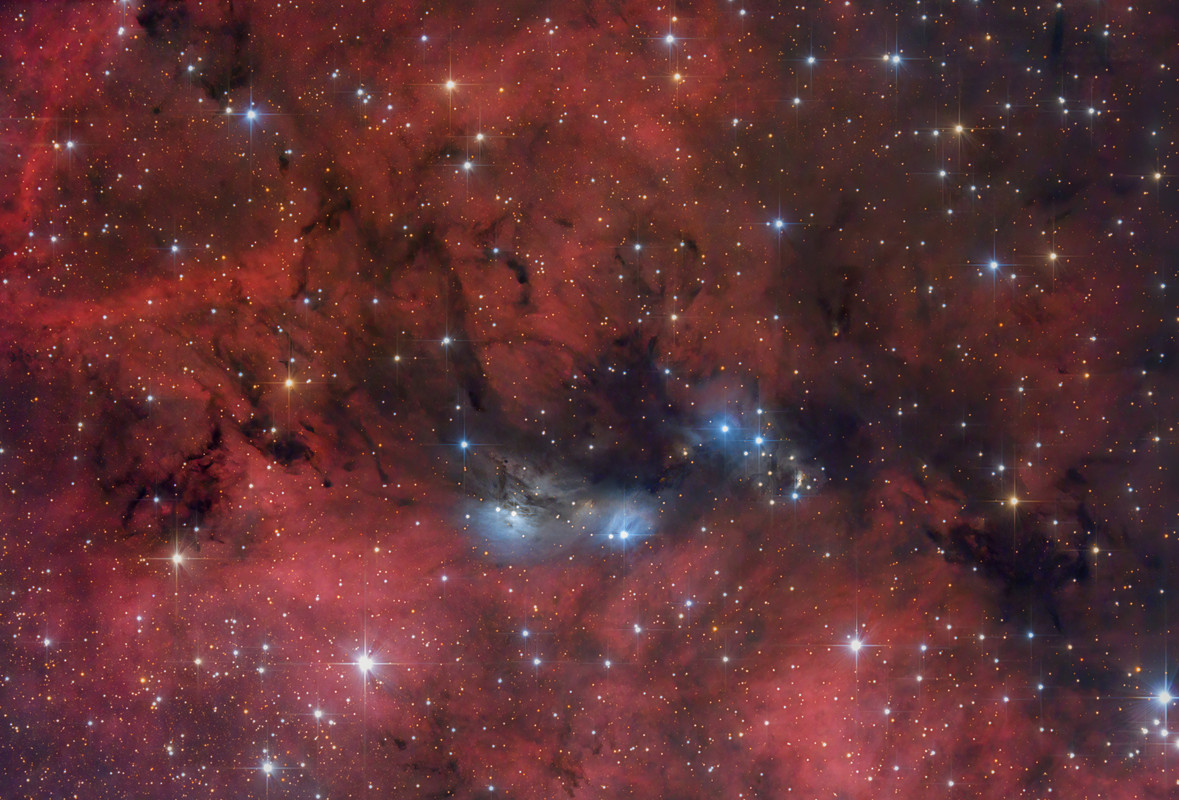
It is difficult to hide a galaxy behind a cluster of galaxies. The closer cluster's gravity will act like a huge lens, pulling images of the distant galaxy around the sides and greatly distorting them. This is just the case observed in the featured image recently re-processed image from the Hubble Space Telescope. The cluster GAL-CLUS-022058c is composed of many galaxies and is lensing the image of a yellow-red background galaxy into arcs seen around the image center. Dubbed a molten Einstein ring for its unusual shape, four images of the same background galaxy have been identified. Typically, a foreground galaxy cluster can only create such smooth arcs if most of its mass is smoothly distributed -- and therefore not concentrated in the cluster galaxies visible. Analyzing the positions of these gravitational arcs gives astronomers a method to estimate the dark matter distribution in galaxy clusters, as well as infer when the stars in these early galaxies began to form.
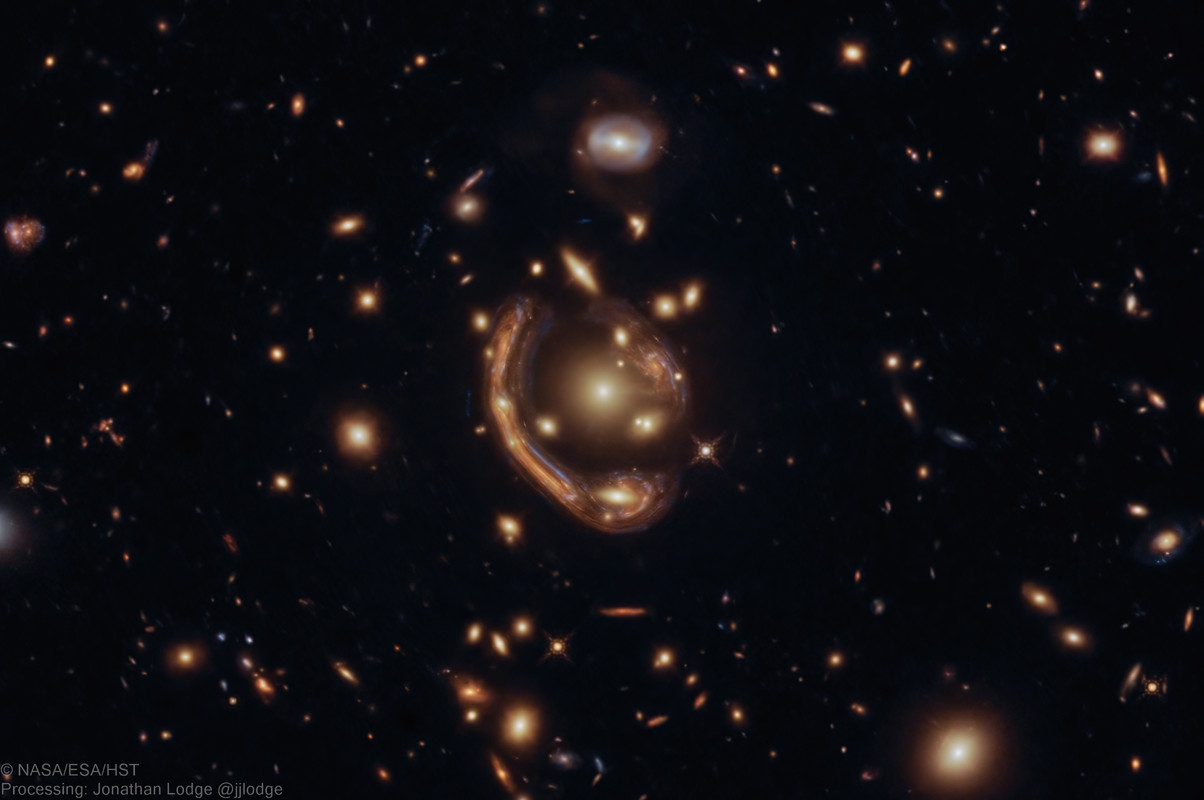
The Hubble Space Telescope captured this glittering scene using its Wide Field Camera 3 and Advanced Camera for Surveys.
Globular clusters are stable, tightly bound groups of tens of thousands to millions of stars. As this image demonstrates, the hearts of globular clusters are densely packed with stars. Terzan 9 is dotted with so many glittering stars that it resembles a sea of sequins.
This starry snapshot is from a Hubble program investigating globular clusters located toward the heart of the Milky Way, in which its central region holds a tightly packed group of stars known as the galactic bulge, an area rich in interstellar dust. This dust makes globular clusters near the galaxy’s center difficult to study, as it absorbs starlight and can even change the apparent colors of stars in these clusters. Hubble's sensitivity at both visible and infrared wavelengths allows astronomers to measure how star colors change due to interstellar dust. Knowing a star’s true color and brightness allows astronomers to estimate its age, and thereby estimate the globular cluster’s age.
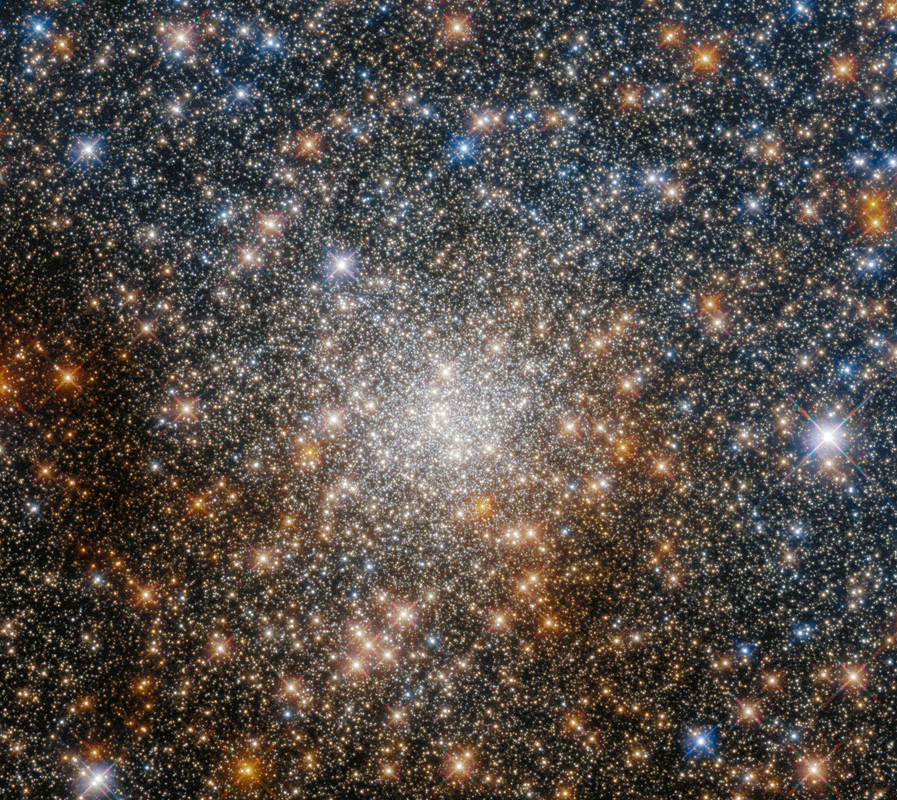
This image features a spectacular set of rings around a black hole, captured using NASA's Chandra X-ray Observatory and Neil Gehrels Swift Observatory. The X-ray images of the giant rings reveal information about dust located in our galaxy, using a similar principle to the X-rays performed in doctor's offices and airports.
The black hole is part of a binary system called V404 Cygni, located about 7,800 light years away from Earth. The black hole is actively pulling material away from a companion star — with about half the mass of the Sun — into a disk around the invisible object. This material glows in X-rays, so astronomers refer to these systems as "X-ray binaries."
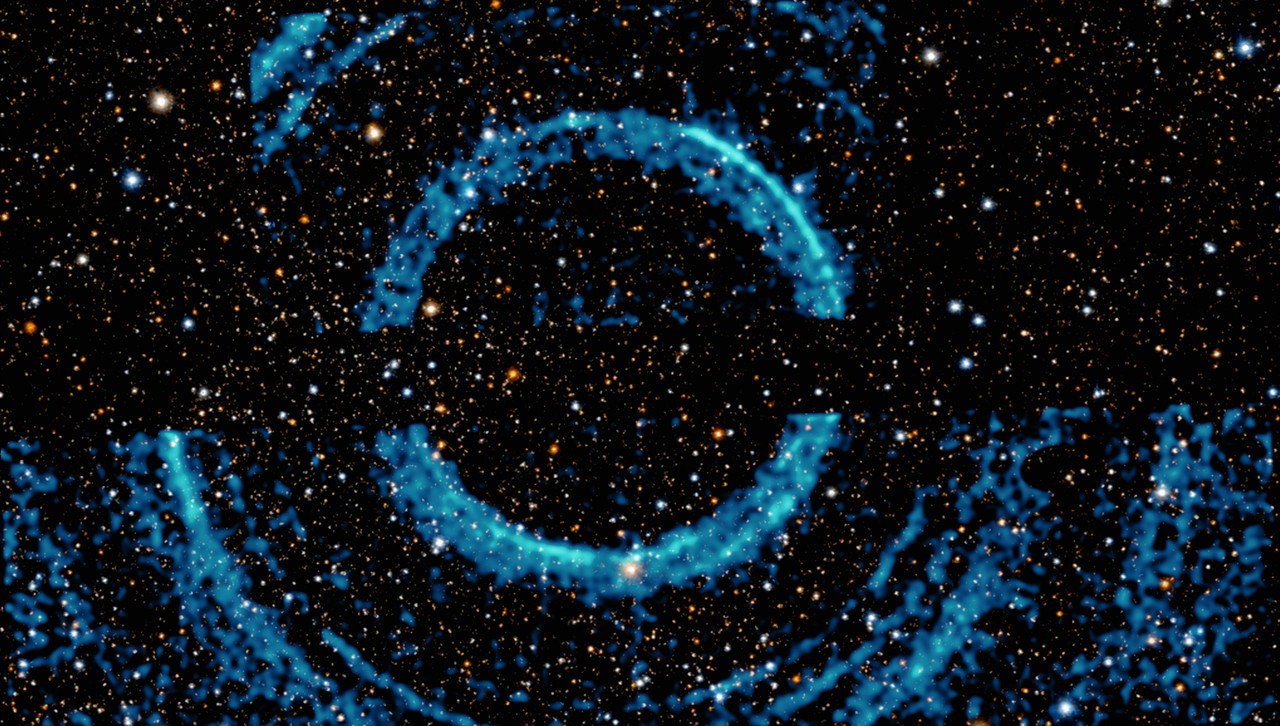
Also, haven't heard much about Starship lately....it's because NASA wanted Artemis to launch before Starship got way ahead of them...that's my conspiracy theory and I'm sticking with it.
Ten thousand years ago, before the dawn of recorded human history, a new light would have suddenly have appeared in the night sky and faded after a few weeks. Today we know this light was from a supernova, or exploding star, and record the expanding debris cloud as the Veil Nebula, a supernova remnant. Imaged with color filters featuring light emitted by sulfur (red), hydrogen (green), and oxygen (blue), this deep wide-angle view was processed to remove the stars and so better capture the impressive glowing filaments of the Veil. Also known as the Cygnus Loop, the Veil Nebula is roughly circular in shape and covers nearly 3 degrees on the sky toward the constellation of the Swan (Cygnus). Famous nebular sections include the Bat Nebula, the Witch's Broom Nebula, and Fleming's Triangular Wisp. The complete supernova remnant lies about 1,400 light-years away.

The Virgo Cluster of Galaxies is the closest cluster of galaxies to our Milky Way Galaxy. The Virgo Cluster is so close that it spans more than 5 degrees on the sky - about 10 times the angle made by a full Moon. With its heart lying about 70 million light years distant, the Virgo Cluster is the nearest cluster of galaxies, contains over 2,000 galaxies, and has a noticeable gravitational pull on the galaxies of the Local Group of Galaxies surrounding our Milky Way Galaxy. The cluster contains not only galaxies filled with stars but also gas so hot it glows in X-rays. Motions of galaxies in and around clusters indicate that they contain more dark matter than any visible matter we can see. Pictured here, the heart of the Virgo Cluster includes bright Messier galaxies such as Markarian's Eyes on the upper left, M86 just to the upper right of center, M84 on the far right, as well as spiral galaxy NGC 4388 at the bottom right.

A study in contrasts, this colorful skyscape features stars, dust, and glowing gas in the vicinity of NGC 6914. The interstellar complex of nebulae lies some 6,000 light-years away, toward the high-flying northern constellation Cygnus and the plane of our Milky Way Galaxy. Obscuring interstellar dust clouds appear in silhouette while reddish hydrogen emission nebulae, along with the dusty blue reflection nebulae, fill the cosmic canvas. Ultraviolet radiation from the massive, hot, young stars of the extensive Cygnus OB2 association ionize the region's atomic hydrogen gas, producing the characteristic red glow as protons and electrons recombine. Embedded Cygnus OB2 stars also provide the blue starlight strongly reflected by the dust clouds. The over 1 degree wide telescopic field of view spans about 100 light-years at the estimated distance of NGC 6914.

It is difficult to hide a galaxy behind a cluster of galaxies. The closer cluster's gravity will act like a huge lens, pulling images of the distant galaxy around the sides and greatly distorting them. This is just the case observed in the featured image recently re-processed image from the Hubble Space Telescope. The cluster GAL-CLUS-022058c is composed of many galaxies and is lensing the image of a yellow-red background galaxy into arcs seen around the image center. Dubbed a molten Einstein ring for its unusual shape, four images of the same background galaxy have been identified. Typically, a foreground galaxy cluster can only create such smooth arcs if most of its mass is smoothly distributed -- and therefore not concentrated in the cluster galaxies visible. Analyzing the positions of these gravitational arcs gives astronomers a method to estimate the dark matter distribution in galaxy clusters, as well as infer when the stars in these early galaxies began to form.

The Hubble Space Telescope captured this glittering scene using its Wide Field Camera 3 and Advanced Camera for Surveys.
Globular clusters are stable, tightly bound groups of tens of thousands to millions of stars. As this image demonstrates, the hearts of globular clusters are densely packed with stars. Terzan 9 is dotted with so many glittering stars that it resembles a sea of sequins.
This starry snapshot is from a Hubble program investigating globular clusters located toward the heart of the Milky Way, in which its central region holds a tightly packed group of stars known as the galactic bulge, an area rich in interstellar dust. This dust makes globular clusters near the galaxy’s center difficult to study, as it absorbs starlight and can even change the apparent colors of stars in these clusters. Hubble's sensitivity at both visible and infrared wavelengths allows astronomers to measure how star colors change due to interstellar dust. Knowing a star’s true color and brightness allows astronomers to estimate its age, and thereby estimate the globular cluster’s age.

This image features a spectacular set of rings around a black hole, captured using NASA's Chandra X-ray Observatory and Neil Gehrels Swift Observatory. The X-ray images of the giant rings reveal information about dust located in our galaxy, using a similar principle to the X-rays performed in doctor's offices and airports.
The black hole is part of a binary system called V404 Cygni, located about 7,800 light years away from Earth. The black hole is actively pulling material away from a companion star — with about half the mass of the Sun — into a disk around the invisible object. This material glows in X-rays, so astronomers refer to these systems as "X-ray binaries."





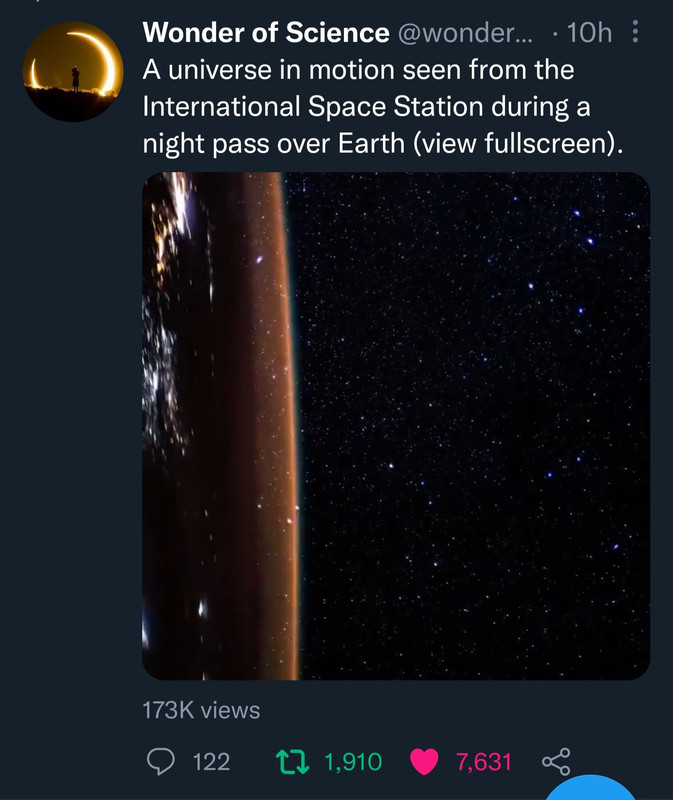




 You may need a large scope to see Bern-Bern, or BB as at perihelion
You may need a large scope to see Bern-Bern, or BB as at perihelion
